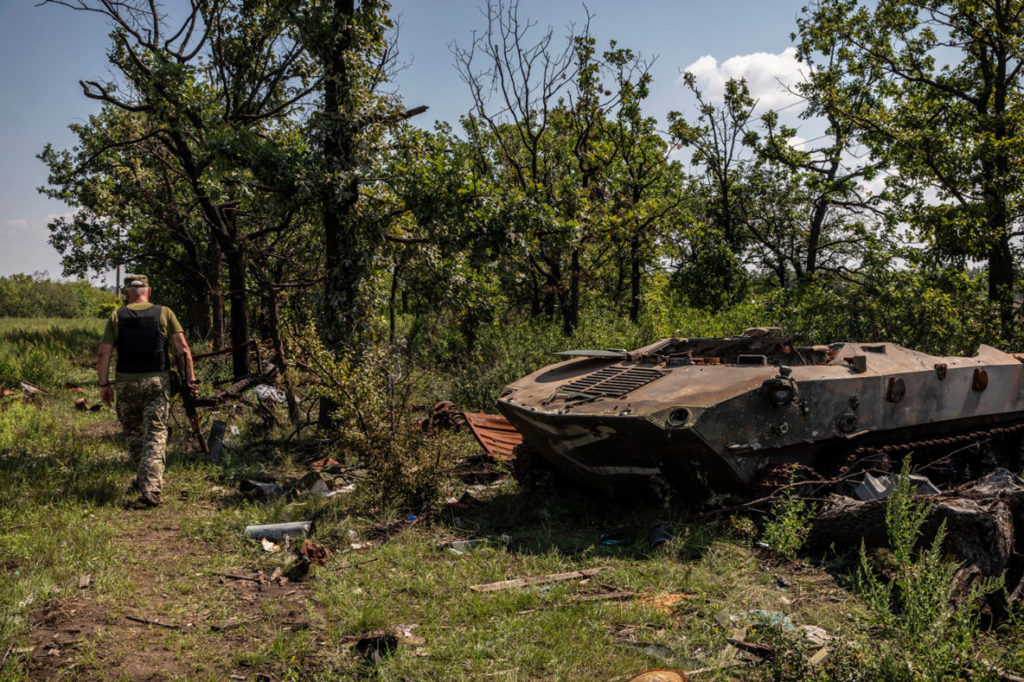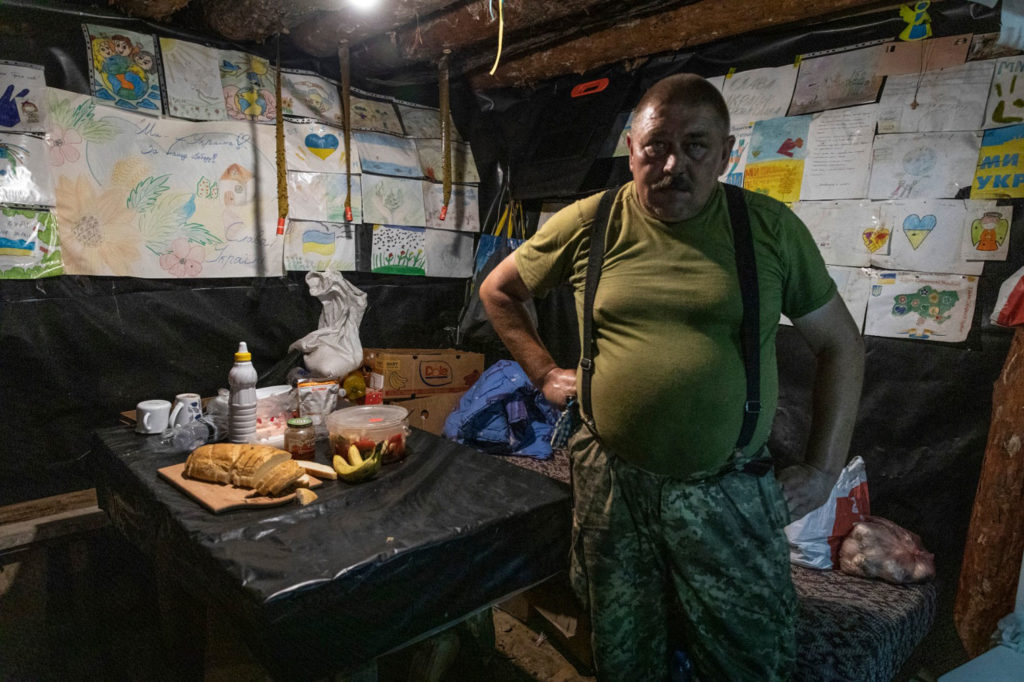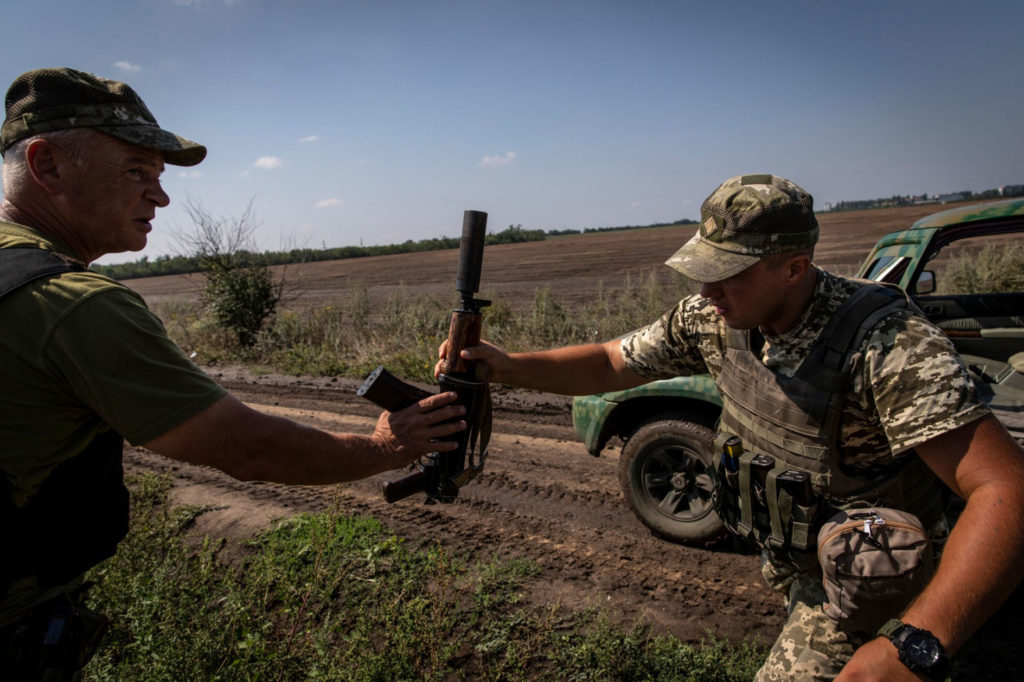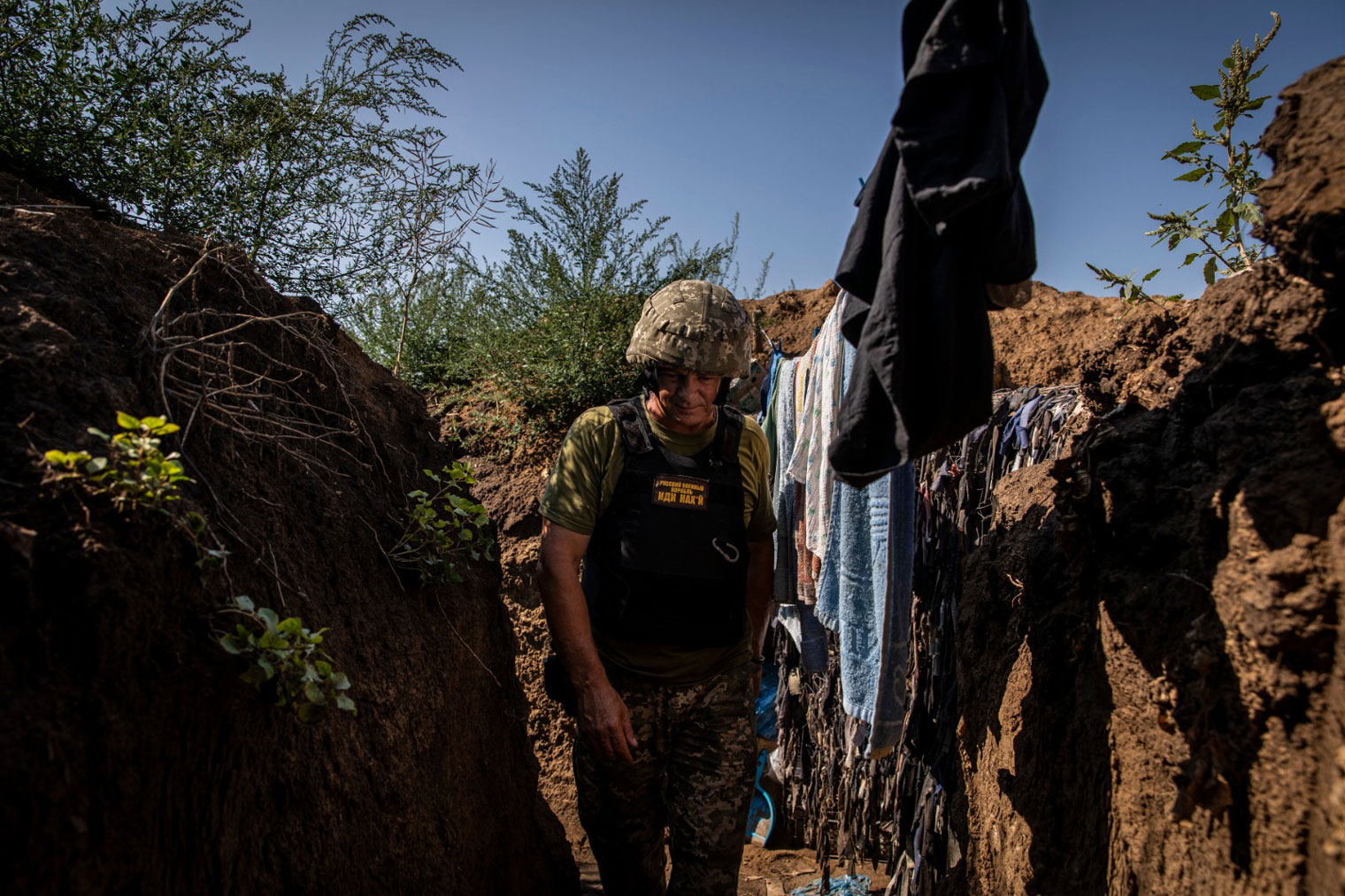A few miles from the front lines in southern Ukraine is a cemetery of twisted metal and charred flesh. Ukraine’s glorious sunflower fields are wilting, and the fields of the south are flooded with early autumn rains. These seem glum omens for Ukraine’s long heralded counteroffensive in the Kherson region — which the Ukrainian southern command reported has just begun, although it is unclear how much, if any progress has been made.
Several times our cars are stuck in the mud, and we are forced to traipse through vast wheat fields on foot. Spires of rusted steel from the carcasses of tanks and armored personnel carriers serve as the tombstones for hundreds of Russian soldiers killed during their doomed assault on the city of Mykolaiv.
In early March, a local farmer had seen the Russian positions as the invaders prepared to storm the city and had sent the coordinates to the regional administration, who pounded the field full of artillery fire. The soft whump of artillery in the distance sounds to the east of us, as Anatoliy, a local military official, tells us that around 100 armored vehicles and at least double that number of soldiers were killed in this single barrage. Next to the wreckage, he points out an unmarked grave where the Russians buried dozens of their dead in the space of a few square yards of soil. This is where the Russian push in southern Ukraine was stopped in its tracks.
On Feb. 24, as armored columns raced from Belarus and Russia in an effort to storm Kyiv and Kharkiv, Ukraine’s two largest cities, another force poured out from Crimea. Its target was the port city of Odesa, Ukraine’s biggest trading port. In early March, apparently with the help of Ukrainian saboteurs, the Russians captured the regional capital of Kherson but were pushed back at the gates of Mykolaiv. Kherson remains the only major city outside of the Donbas region the Russians have seized and has now become the projected target of a counteroffensive. Since the delivery of long-range Western rocket systems, including HIMARS (High Mobility Artillery Rocket System) in mid-July, Ukrainian forces have been striking Russian ammunition depots in the regions, as well as heavily damaging the bridges leading from Crimea to the Kherson region.

Authorities in Kyiv discussed the prospects of a counteroffensive against Russian-occupied territories in the south for several months now. In July, one official said they expected the Kherson region to be liberated by September. In response, the Russian army rerouted thousands of troops from the Donbas to the south and prepared extensive fortification. Now, Ukrainian forces have reported striking Russian positions throughout Kherson oblast, particularly near Nova Khakhovka, and breaking through the Russian first line in at least one position.
However, on a recent trip to the region, local authorities were downbeat about the prospect for a quick military success. “We can only attack when we are ready,” said Dmitro Pletenchuk, a spokesperson for the regional military administration. “We need to train more troops and destroy Russian ammunition and logistics. And we need you to send us more weapons like HIMARS. We need long-range rocket systems and air defense to counter their ability in aircraft.” On Aug. 24, the 31st anniversary of Ukraine’s independence from the Soviet Union, the U.S. announced an extra $3 billion in military assistance that includes new air defense and anti-drone capabilities.
On the ground, soldier to soldier, Pletenchuk predicted the Ukrainians would wipe the floor with their Russian foes. But he noted that the open ground between Kherson and Mykolaiv would make any Ukrainian offensive vulnerable to Russian aircraft stationed in Crimea, as well as the Russian Black Sea Fleet. Mykolaiv’s regional officials said they expect more small tactical successes over the coming months — but nothing that would change the overall strategic picture.
It is unclear what changed in the meantime — it is possible that Ukrainian authorities have been deliberately coy about their intentions to try and confuse the Russians about their intended strategy.
Or, they could have noticed an unforeseen weakness in the enemy positions that necessitated bringing the timetable forward to take advantage of the situation. More concerning would be if political considerations from the Zelenskyy government — eager to prove to Ukraine’s Western backers that they are making progress — overrode the judgment of local commanders that it was too early for an assault.
When the Biden administration announced its new weapons package, it noted that it was designed for the “medium to long term” and that some new capabilities would take years to come online. This suggests that the U.S. expects the conflict to drag on.
The front lines in the Kherson region were mostly stable since mid-March. There is still fierce fighting, but the intensity is noticeably less than in the Donbas region, which I visited several months ago. The entire eastern region still under Ukrainian control looks and feels like a giant fortress. In the southern Mykolaiv region, you can drive for miles without seeing signs of military activity, although the city itself was shelled heavily shortly after the counteroffensive was announced on Aug. 29. When we visited military positions near the front line, the soldiers we spoke with were recently mobilized recruits who had only a few weeks of basic training. Several appeared noticeably unfit and had aging equipment. This was a clear contrast to the well-trained, experienced and highly motivated troops I had met on the front lines in the Donbas.

In the village of Shevchenkove in Mykolaiv region, around 5 miles from the nearest Russian positions, locals have grown used to the constant shelling. “My house has already been hit five times from cluster munitions,” Valentine Kuchner, a 51-year-old farmer says as he offers us some ripe plums from his garden. “It is still very scary, but it has become our regular life now. He has kept the spent shell of one rocket lying between a flower bed and a wheelbarrow full of soil. His wife, daughter and grandchildren are all in Poland, but his 75-year-old mother refuses to leave her hometown, so he stays to look after her. When the Russians begin firing in the early morning between 3 and 8, he stays in his basement. “My mother has thought about leaving, but she has two cows, 10 dogs and 15 cats to look after!” So, they have decided to stay until the end of the war or “after the victory” as Ukrainians now refer to that unknown future date.
Justin Bronk, an air power expert at the Royal United Services Institute, told New Lines, “I don’t think they ever intended a frontal assault on the city of Kherson directly,” adding, “I wouldn’t be surprised if instead, they attempted to draw Russian manpower from [the] Donbas and thereby spread them too thin to continue their assault on [the] Donbas.” Rather than storm the city, he said that the Ukrainians should aim to keep pressure on Russian logistics supplies and attempt to cut their ground lines of communications to Crimea.
“The Russians have so far shown a complete unwillingness to fight when there is even the slightest threat of them being encircled,” Bronk explained. “When the Ukrainians threatened to encircle the troops near Kyiv, they withdrew immediately. They didn’t even attempt to maintain a presence near the city to fix Ukrainian troops in position.” This will be a long and slow process, but it is far less risky than an attempt to storm the city.
Immediate reports on the situation have suggested that Ukrainians have been attempting to breakthrough in the northern parts of the front line, from position the city of Krivyi Rih and toward occupied Nova Kakhovka rather than from Mykolaiv, suggesting this analysis could be an accurate approximation of Ukrainian war aims.
For some time now, a stalemate has been looming, not just in the region, but in the wider war. Since the Russians secured the whole of Luhansk oblast with their capture of Sievierodonetsk and Lysychansk in mid-July, they have made gains measured in single-digit miles and have failed to capture any new significant settlements. This counteroffensive could be the last throw of the die from either side before both sides hunker down for the winter.
Back in nearby Odesa, the target of Russian President Vladimir Putin’s southern campaign, life looks almost back to normal. Tank traps and sandbags have disappeared from the streets, while restaurants and bars are back open. Only an 11 p.m. curfew disturbs the city’s once-bacchanalian nightlife. The only signs of war are the billboards and posters hung all over the city depicting Ukraine’s armed forces and an abundance of blue and yellow flags hung from seemingly every window and balcony. One poster on the walls of a bus stop features a pair of doves with the words “Kherson is in our hearts.”
After six months, the overall situation is both manageable but deeply unsatisfactory for both sides. For one, Ukraine has survived as a nation and as a state — an outcome that was deeply in doubt at the start of the invasion. It has lost about 10% of its sovereign territory — in addition to the 10% it lost with Crimea and Donbas during the original Russian invasion in 2014 — but only one provincial capital. The three key cities of Kyiv, Kharkiv and Odesa remain firmly in Ukrainian hands.
The Russians have suffered extraordinary losses but have taken a large majority of the Donbas — their ostensible goal for their operation. They have also secured a land corridor to occupied Crimea. Theoretically, Putin could capture the remainder of Donetsk and plausibly convince his domestic audience of a victory.

But both sides are equally past a point of no return. Ukraine’s early and unexpected victories have convinced both the population and government officials that a complete restoration of Ukraine’s occupied territory, including the Donbas areas controlled by Russian proxy forces since 2014 and the Crimean Peninsula annexed by Russia in 2014, is possible. Ukraine President Volodymyr Zelenskyy doubled down on this in his Independence Day address, saying that Ukraine would recover all of its occupied territories.
“Russian aggression began in Crimea,” he told the country, “and its finale will be in Crimea as well.”
Putin, in turn, has staked the legitimacy of his regime on victory in Ukraine. He has long since dispensed with the fig-leaf excuses of NATO expansion and “protecting” the Donbas, which he has mostly destroyed. Russian officials and propagandists’ justifications for the war now veer from expansionist to outright genocidal. While neither side desperately needs an immediate military advance, both also deny the possibility of a negotiated peace any time soon. This will be a long, slow fight to the death until one side is exhausted.
In the tank graveyard outside Mykolaiv, Anatoliy tells us a sly joke. He points to the uniform of a Russian soldier that had been caught in the top branches of a tree when the vehicle he had been driving was blown up. He grins and says to us: “Putin said that if there is a world war, all the Russians will go to heaven. Well, this man tried but got caught on the way up there!”



